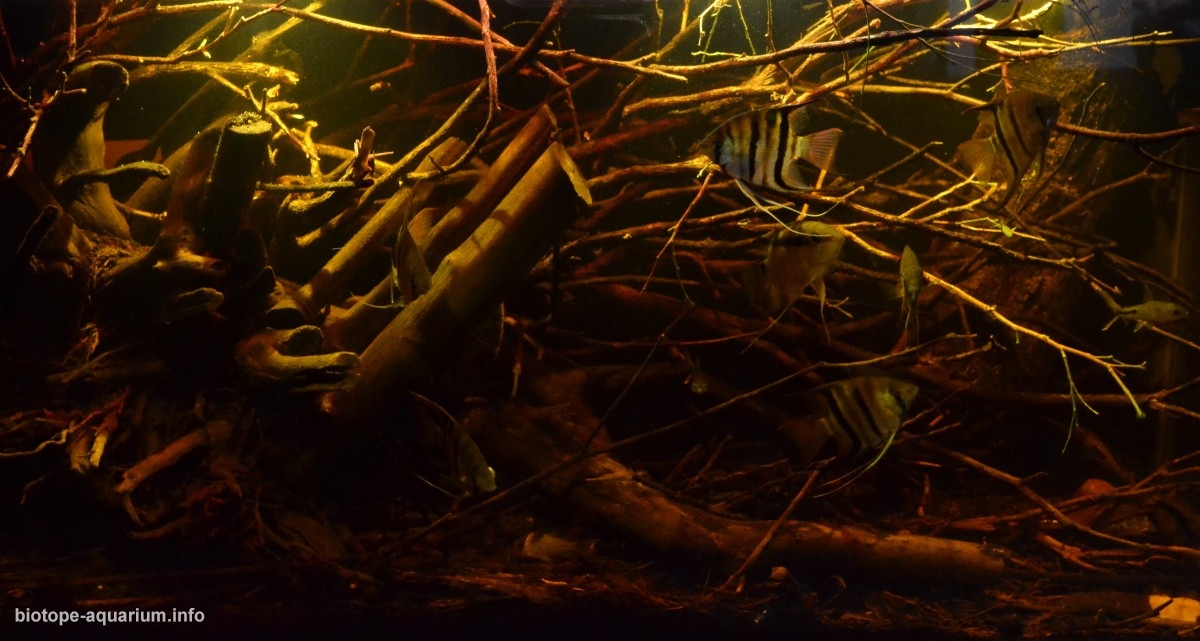Rio Negro in Barcelos region, Brazil
116th place in Biotope Aquarium Design Contest 2019
Brazil. Jose Antonio dos Reis

Volume: 360 L
Dimensions: 120x50x60 cm
List of fishes: Pterophyllum leopoldi, Mesonauta egregius, Corydoras sp.
List of plants: –
Description of decorations: I used the sand and litter mix No. 2 Pterophyllum Projekt
Description of equipment: Filtration is with 130 liter sump. The first layer is filter cotton and the others are laying ceramic ring for nitrifying bacteria. The water pump is Sarlo Beter 2000. Two led lamps, one has a color temperature of 3,000k. 2 200 w visiotherm heaters
Water parameters: Temperature is 26 ℃, pH is 4.5 gH 3.
Additional info: –
INFORMATION ABOUT BIOTOPE
Description of the area surrounding the biotope: The Negro River is the largest tributary of the left bank of the Amazon River in the Amazon, South America. It is the longest river of black water in the world, and the second largest in volume of water – behind only the Amazon, which helps to form. It has its origin between the Orinoco and Amazon basins. Connects with Orinoco through the Cassiquiare channel. In Colombia, where it has its source, it is called the Guainia River. Its main tributaries are the Rio Branco and the Vaupés River. It disputes being the beginning of the Orinoco River along with the Guaviare River. Drains the eastern Andes in Colombia. After passing through Manaus, it joins the Solimões River and, from that union, the latter becomes the Amazon River.
Description of the underwater landscape of the biotope: Blackwater river but with crystal clear water, with large amount of branches and leaves deposited in the background, the substrate and fine sand mixed with forest litter
Description of the parameters of the habitat: Black water is extremely poor in mineral salts, nutrients and electrolytes due to poor movement and soft relief of its source regions, Guiana and Central Brazil Shields or in tertiary sediments, where erosion processes they are low intensity and reduced by the forest cover where the water from precipitation penetrates the soil covered by vegetation and carries with it various organic substances. Humic substances are composed of humic and fluvic acids and originate during the process of decomposition of plant residues. The low ion content plus the presence of humic substances give black waters an acid character with pH values between 4.8 and 5.1. The large amount of humic substances and dissolved organic carbon (DOC) (10 to 14 mgC.L -1) from decomposition of organic material is largely responsible for the transparent red / brown coloration of water.
List of fishes and invertebrates occurring in the nature biotope: The complete list of local ichthyofauna is immense, but here is the link to the conference. https://www.fishbase.se/trophiceco/FishEcoList.php?ve_code=63
List of plants found in the nature biotope: –
Threats to the ecology: The Amount Raised distributed among families practicing ornamental fishing means family support with lawful activity and strong appeal preservationist, because without this resource, such for other activities intended to feed their families, such as sport fishing, acting as guides and / or fishing capturing turtles illegally, hunting animals logging and clearing wood that can cause environmental degradation, as has been the case with the gold mining and logging. The ornamental fish of the municipalities of Barcelos and Santa Isabel do Rio Negro, in Amazonas, have obtained from the National Institute of Industrial Property (INPI) an unprecedented certification in the world: a kind of “green seal” with Indication of Geographic Origin, granted by the first once to a living organism.
Sources of information:
http://www.finarama.com/gallery/amano.htm
https://gia.org.br/portal/caracteristicas-fisicas-e-quimicas-dos-rios-amazonicos/
https://www.fishbase.se/trophiceco/FishEcoList.php?ve_code=63
